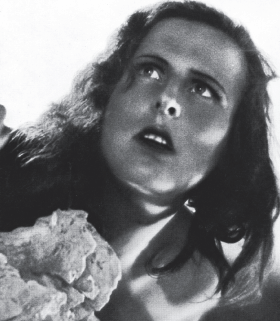Movies and Film: Hitler's Hired Help
Hitler's Hired Help

Leni Riefenstahl starring in her own directorial debut, The Blue Light (1932).
One of the most bizarre and fascinating documentaries you'll ever see is Ray Mller's The Wonderful, Horrible Life of Leni Riefenstahl (Die Macht der Bilder: Leni Riefenstahl, 1993), a three-hour epic look at the biography of one of filmdom's most perplexing figures. Leni Riefenstahl, who died in 2003 at the age of 101, was truly one of the most remarkable and disturbing figures in the history of cinema. Her life and career testify to the inextricability of the cinema from the tragic history of Germany in the twentieth century.
Born into a wealthy Berlin family in 1902, Riefenstahl's first break into film was a role in Der heilige Berg (Peaks of Destiny, 1926), by director Arnold Fanck. In the following years she appeared in several other of Fanck's so-called mountain films, giving a recognizable, healthy, and properly Aryan face to a genre that would soon become associated with the racist aspirations of the emerging Nazi party.
After becoming a well-known figure in mountain films, Riefenstahl wrote and directed her own contribution to the genre in 1932. In terms of its visual effects and cinematography, Das blaue Licht (The Blue Light) is one of a handful of remarkable pre-World War II German films. Combining a tale of mountain-climbing adventure with a story of passionate love, the film infuses its visual splendor with a deep-seated Germanic mysticism that celebrates the spirit and vitality of the Alpine landscape.
Filmophile's Lexicon
Mountain films (Bergfilme) were a popular genre of Austrian, German, and Swiss motion pictures in the 1930s that featured dramatic, challenging mountain landscapes coupled with equally challenging human situations confronting the protagonists.
Second Take
You've probably seen clips from Triumph of the Will without knowing it: the mass of German troops marching in lock-step, the camera rising slowly from ground level to take in the rows and columns of Nazi military might, Hitler's triumphant arrogance as he surveys his loyal subjects. The film's haunting images have been permanently branded on the collective memory of Europe.
Short Cuts
"They kept asking me over and over again whether I was having a romance with Hitler. 'Are you Hitler's girlfriend?' I laughed and answered the same way each time: 'No, those are false rumours. I only made documentaries for him.'"
—Leni Riefenstahl
Unfortunately, however, The Blue Light and other German mountain films from this period also went to great lengths to celebrate the spirit and vitality of the Aryan Volk who were quickly becoming the Nazi regime's obsession. The whiteness of the driven snow and the robust Teutonic energy of Riefenstahl's heroines can and should be viewed as symbols of a growing sense of racial superiority that led to the greatest human tragedy of the twentieth century.
It's no accident that, in the early 1930s, Riefenstahl was hand-picked by Adolf Hitler to direct a series of documentary films in direct propagandistic support of the Nazi party. The first and most influential of these is Triumph des Willens (Triumph of the Will, 1935).
Shot as a commemoration of the 1934 rally in Nuremberg, Triumph of the Will will always be remembered and loathed as perhaps the most dazzling and successful propaganda film ever made.
Riefenstahl's other well-known Nazi-commissioned film is Olympia (1938). If less explicitly propagandistic, this two-part documentary treatment of the Olympic Games held in Berlin in 1936 is equally disturbing. Riefenstahl used novel camera positions, slow motion, long lenses, and creative editing to depict the athleticism of the human body in entirely new ways, all the while celebrating the specifically Aryan body at the expense of, for example, Jesse Owens and other nonwhite athletes who contributed importantly to the 1936 Olympics.
What made Riefenstahl such a fascinating figure, though, was what happened to her since the end of World War II. After a failed attempt at a "comeback" in the 1950s, she spent years living with and filming the Nuba tribe in Africa. Her last project, Impressionen unter Wasser (Underwater Impressions), which some refer to as "oceanographic cinematography," resonates disturbingly with the fetishization of the spectacular at work in Triumph of the Will. It was released on her 100th birthday.
Mller's superb documentary will give you an informative and appropriately grand entree into the life of German film's most confounding figure.

Excerpted from The Complete Idiot's Guide to Movies and Film © 2001 by Mark Winokur and Bruce Holsinger. All rights reserved including the right of reproduction in whole or in part in any form. Used by arrangement with Alpha Books, a member of Penguin Group (USA) Inc.
To order the e-book book direct from the publisher, visit the Penguin USA website. You can also purchase this book at Amazon.com.
